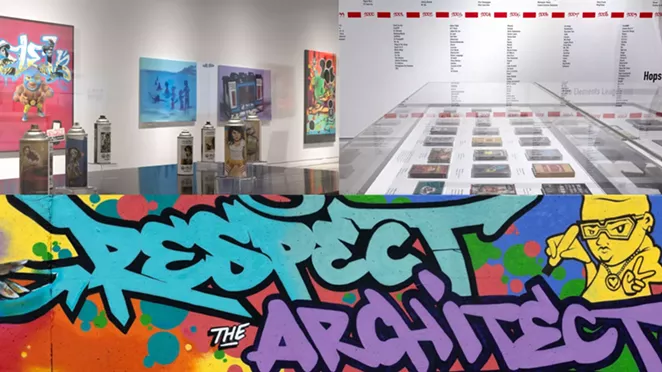Two levels; two deep-dive exhibitions; one price: free.
Since Sep 21, the Mount Saint Vincent University Art Gallery has brought together two shows to explore the art of hip hop—the graffiti, the music, the people, the movement—and how it lends itself to groundbreaking forms of archival work and scholarship that honours hip hop’s ongoing 51-plus-year music, aesthetic and cultural legacy. Still Tho: Aesthetic Survival in Hip Hop’s Visual Art, curated by Mark V. Campbell, and East of East Atlantic Hip Hop Archive, curated by Michael McGuire, are at the tail end of their final week, both coming down after 5pm this Sunday, Nov 23.
Still Tho has also expanded outside the gallery with the “Respect the Architects Mural,” created by exhibiting artists Kalkidan Assefa AKA Drippin Soul, and Mique Michelle alongside local artist Darren Pyper AKA Ghettosocks. Learn more about the artists’ inspirations here. The mural was co-organized by the MSVU gallery and North Side Hop Hop Archive, founded by Campbell in Toronto in 2009, to open in conjunction with Still Tho and remain indefinitely along the Bedford Highway.

Keely Hopkins / MSVU Art Gallery
Section of “Respect the Architects” mural on the Bedford Highway and Melody Drive. Artists: Mique Michelle, Kalkidan Assefa (Dripping Soul) and Darren Pyper (Ghettosocks).
To see both shows before they’re gone, visit the gallery Thursday Nov 21 before 7pm, or Friday through Sunday from 12-5 pm. For more information on getting there, visit the gallery’s website.
Still Tho: Aesthetic Survival in Hip Hop’s Visual Art
Keely Hopkins / MSVU Art Gallery” class=”uk-display-block uk-position-relative uk-visible-toggle”>
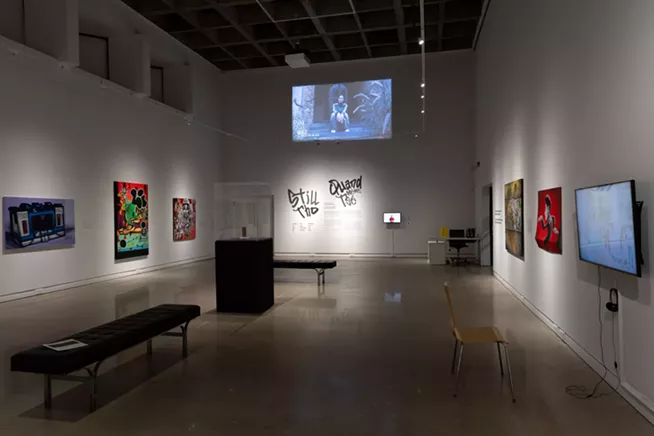
Keely Hopkins / MSVU Art Gallery
Curated by Mark V. Campbell, this show pays tribute to the Canadian artists who’ve shaped hip hop and its visual aesthetics. This group show features 13 artists from across Canada—Kalkidan Assefa, Corey Bulpitt, Curly, EGR, Eklipz, Elicser Elliott, Nelson “Dedos” Garcia, Mique Michelle, MissMe, STARE, Mark Stoddart, Mark Valino and Wizwon (Jayde Goodon)—whose mixed-media works centres around the practice, language, influence and temporal storytelling of graffiti art—including through improvised, interpretive dance.
[embedded content]

Keely Hopkins / MSVU Art Gallery
Still Tho installation view at the MSVU Art Gallery; (foreground) “EGR Art on Vintage Spray Cans” by EGR; (background left) “Coltan Kills” by Eklipz; (background centre) “A Day at the Beach” and “Untitled” by Elicser Elliott; (background right) “Fantasia 1987 – Hail the Lizard King” by Curly
Campbell tells The Coast he wants people who visit the show—Halifax is the final stop in a three-continent tour—to “encourage Canadians to have pride in the culture that comes out of this country.”
Says Campbell, “we can’t have that pride until we know what we’ve done. We’ve had a chance to reflect on what has happened, what has been built, what has survived and what has defied the odds: be it a lack of infrastructure, American media, imperialism or our lack of self-confidence around Canadian culture.”
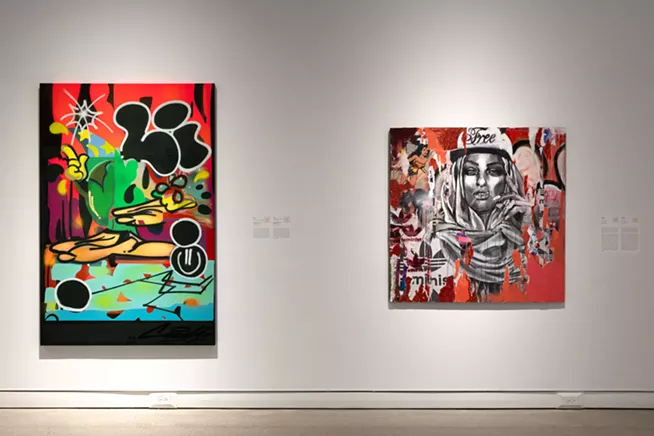
Keely Hopkins / MSVU Art Gallery
Still Tho installation view at the MSVU Art Gallery; (left) “Fantasia 1987 – Hail the Lizard King” by Curly; (right) “Free Cap” by Miss Me.
He wants people to walk away feeling proud they’re from Canada, of what various cities and scenes across the country have accomplished, “and that there are other places in Canada where people are innovating—not just in visual work. By critically engaging in keeping hip hop culture alive, and not just by consuming it, by contributing to it, by understanding the aesthetic rules and by innovating around the lack of infrastructural support or the noses that get turned up at other galleries that don’t want us there.”
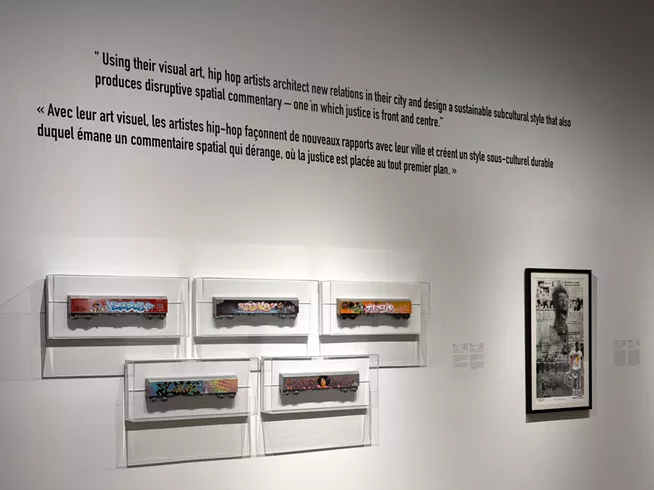
Keely Hopkins / MSVU Art Gallery
Still Tho installation view at the MSVU Art Gallery; (left) “Take the Train” by Eklipz; (centre) “Fight the Power” by Mark Stoddart; (right top) “Don’t Shoot,” record cover for TimeKode X Vol. 2, by Kalkidan Assefa; (right bottom)
The title “Still Tho” echoes a common expression in hip-hop culture, which is about the perseverance, defiance, resilience and explosive influence of hip hop culture and visual art on Canadian culture and new forms of aesthetic production in the digital age.
“I want people to feel a sense of empowerment and pride that this is our culture, and this is now 51-plus years, and that we continue to stimulate Canadian culture and enrich the fabric of this place, even if they don’t want us here.”
East of East Atlantic Hip Hop Archive
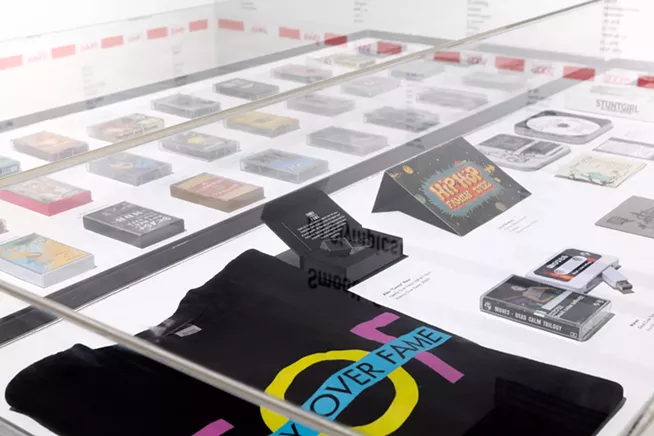
Keely Hopkins / MSVU Art Gallery
East of East Atlantic Hip Hop Archive Installation view in the MSVU Art Gallery.
Curated by the founder of the East of East Atlantic Canadian Hip Hop Archive, Michael McGuire—who is an artist and academic, currently teaching in cultural studies at MSVU. McGuire started the archive in 2017 to preserve the cultural legacy of the area’s hip hop artists and their visual art—show flyers, videos and album covers. He now has a collection of over 2,100 recordings, 400 posters and nine hours of video, along with 850 CDs, 165 cassettes and 280 vinyl records dating back to the ‘80s that he’s curated into a shareable, interactive show for the first time ever.
“I’d always known there was a really interesting history here,” he says. “We’ve had a lot of major international artists come out of here that don’t really get a lot of recognition. They’re known elsewhere, but not really known in their own hometown.”
In the show you can see show posters that people have donated to McGuire over the years, “a bunch of obscure cassettes that take you through the history and shows you the diversity of stuff that’s come out over the years,” Mi’kmaw, Acadian and African Nova Scotian art and music “that you won’t find outside of here,” a playlist of women’s contributions to local hip hop over the years and a scrolling video that looks at all the album covers in the archive—it takes an hour.
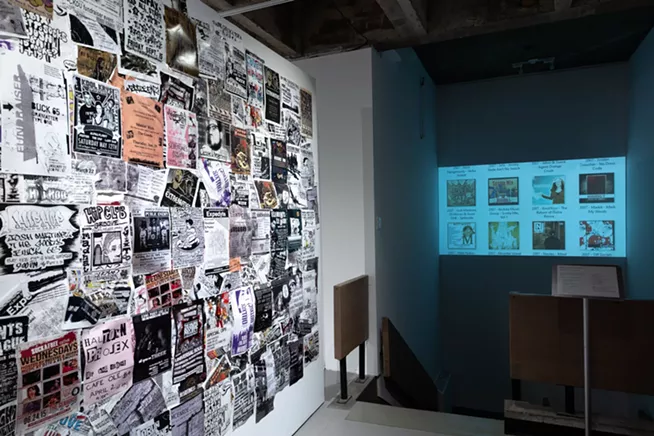
Keely Hopkins / MSVU Art Gallery
East of East Atlantic Hip Hop Archive Installation view in the MSVU Art Gallery.
McGuire started the archive during a dissertation on hip hop culture and spoken word because “no one else was doing any of this stuff.” He says collecting is a constant, everyday, non-stop “Indiana Jones-like” process.
“I’m constantly scouring marketplaces like Discogs,” says McGuire. “I’ve got my want lists, but you also have to search artists’ aliases. I will regularly take day trips around the Maritimes to go and dig through thrift shops and record shops and whatever, because most of the stuff that I’m looking for is local stuff that was independently produced, so often the artists themselves don’t have copies.
“My hope is that somebody gave a copy to their aunt or their cousin; it lived in a box, and now they’ve taken that box to Value Village, and hopefully I can get to it before it’s gone.”
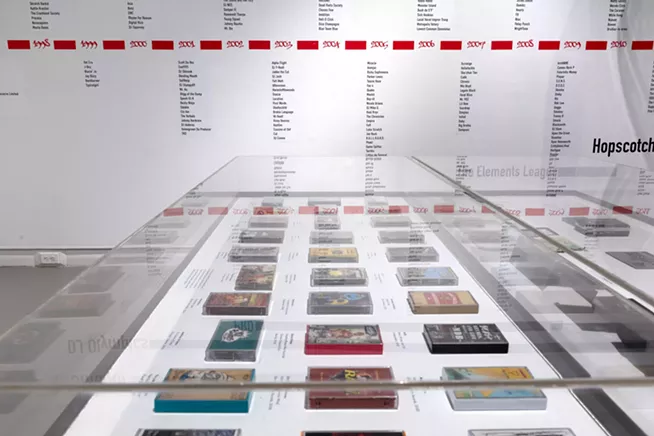
Keely Hopkins / MSVU Art Gallery
East of East Atlantic Hip Hop Archive Installation view in the MSVU Art Gallery.
The exhibition is a chance for newcomers and old heads to meet the artists who built up and continue to forge the not-to-be-overlooked vibrant hip hop scene of Atlantic Canada. There’s music, videos, posters and a big wall of history for viewers to add their stories and tips to as part of the archive’s ever-going mission to preserve and document the physical (and digital) materials of this rich cultural tradition—while creating and supporting new projects within the hip hop community.
“I would love to formalize it and give it a home someday,” he says. “Maybe at one of the public libraries or universities.” Hint, hint.
This post was originally published on this site be sure to check out more of their content.



